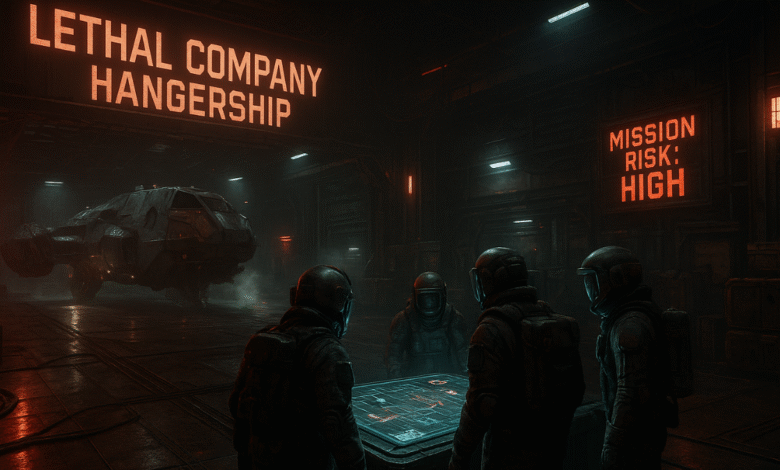Exploring the World of Lethal Company Hangership

Explore the lethal company hangership: a futuristic hub of strategy, survival, and teamwork. Discover its meaning, mechanics, symbolism, and impact on gaming culture.
Introduction to Lethal Company Hangership
The phrase lethal company hangership has recently started capturing attention among gaming communities, digital culture enthusiasts, and content creators. On the surface, it sounds mysterious—partly corporate, partly dangerous, and almost futuristic in its undertones. But once you dig deeper, the concept begins to make sense. It’s more than just a catchy term; it reflects an intersection between gaming environments, survival strategies, and the immersive mechanics of virtual teamwork.
At its core, lethal company hangership represents both a literal and symbolic idea. Literally, it may describe a hangar-like hub or station where dangerous missions are launched in certain sci-fi games. Symbolically, it can be viewed as a metaphor for the dangerous bonds or “ships” companies create, where players and characters must navigate high-risk environments together. This duality makes the term engaging, relevant, and highly discussable.
Origins of the Lethal Company Hangership Concept
The origins of the lethal company hangership concept appear to be tied closely to online multiplayer culture. In many sci-fi or survival horror games, companies act as employers for player-characters, sending them on lethal missions in exchange for in-game currency or resources. The “hangership” part reflects the docking bay, mothership, or central hub where planning, coordination, and logistics happen.
This style of gameplay owes inspiration to titles like Dead Space, Alien: Isolation, and more recently, cooperative indie hits where survival is balanced with strategy. Communities on forums and social media have adopted the phrase lethal company hangership to refer to that unique place between safety and danger—where strategy is made but peril always awaits.
Over time, memes, walkthroughs, and strategy guides began using the phrase, cementing it as a keyword in online searches. Its mysterious vibe only added to its SEO-friendly presence, making it appealing to gamers, bloggers, and even storytellers who wanted to tie the concept into larger narratives.
The Mechanics Behind Lethal Company Hangership
Understanding lethal company hangership requires analyzing its mechanics. Think of it as both a hub and a pressure point. Players begin in the hangership, where they can choose gear, plan strategies, and decide which missions to tackle. It becomes the safe zone before danger, yet it constantly reminds them of looming risks outside.
One key mechanic is resource management. Within the lethal company hangership, players often juggle credits, equipment, and upgrades. This mirrors real corporate environments where budgets dictate actions. In games, a poorly stocked hangership can spell disaster for the team.
Another mechanic involves communication. The hangership is where players align goals. Poor communication can turn lethal missions into outright failures, reinforcing the phrase’s dangerous edge. It’s not just about survival against monsters or hostile landscapes, but about surviving poor teamwork as well.
Symbolism of the Hangership in Virtual Worlds
Beyond mechanics, the lethal company hangership holds rich symbolic meaning. It reflects liminality—a threshold space between safety and hazard. While inside, players feel secure. Yet every decision within directly impacts survival outside. This mirrors real-world boardrooms where corporate leaders make decisions that affect entire teams.
Another symbolic layer involves identity and belonging. For players, the hangership is where friendships are tested, strategies debated, and trust is either forged or broken. In this sense, lethal company hangership represents community dynamics under pressure, not unlike the way employees in high-stakes industries experience teamwork.
“The hangership is more than a hub—it’s a crucible where survival, strategy, and trust are forged.”
Cultural Impact of Lethal Company Hangership
The rise of lethal company hangership has spilled beyond games. On YouTube and Twitch, content creators label their playthroughs with the phrase to attract search traffic. Reddit threads often dissect how to optimize gear inside the hangership, or joke about how chaotic planning phases can be.
Culturally, it highlights our fascination with liminal spaces—those strange zones where safety and danger overlap. Just as airports, train stations, or corporate boardrooms carry their own charged energy, the lethal company hangership embodies a similar aura in digital worlds.
Memes further amplify the concept. Screenshots of messy hangership planning, failed team strategies, or hilariously botched missions are shared widely, giving the phrase a humorous life of its own.
Table: Comparing Lethal Company Hangership with Similar Concepts
| Feature | Lethal Company Hangership | Mothership (Classic Sci-Fi) | Safehouse (Survival Games) |
|---|---|---|---|
| Function | Hub for planning & gear | Central command unit | Resting place |
| Risk Factor | Medium (planning errors) | High (enemy targeting) | Low (safety guaranteed) |
| Symbolism | Liminal safety & risk | Authority & dominance | Respite & recovery |
| Cultural Popularity | Rising in gaming culture | Classic sci-fi trope | Longstanding survival trope |
Why Gamers Love the Lethal Company Hangership
Gamers are drawn to the lethal company hangership because it creates tension before the action even begins. There’s something thrilling about strategizing in a space that feels safe, yet knowing one wrong choice can lead to in-game disaster.
Additionally, the lethal company hangership caters to different playstyles. Some enjoy micromanaging every credit and resource, while others thrive on teamwork and communication. Its versatility ensures that players of all backgrounds can find something engaging.
Finally, it taps into nostalgia. Many gamers grew up with sci-fi tropes like docking bays or mission hubs. The lethal company hangership updates these tropes for modern cooperative gameplay, giving it both freshness and familiarity.
Community Stories and Experiences
If you spend time in online forums, you’ll find countless anecdotes about lethal company hangership experiences. Players often share tales of hilarious mismanagement—like spending all credits on useless gadgets, only to fail spectacularly. Others recount intense survival victories where flawless planning led to triumphant missions.
These stories highlight the hangership as a social hub as much as a gameplay one. It’s the stage for humor, drama, and bonding, making it a cultural anchor in gaming circles.
FAQs about Lethal Company Hangership
What is a lethal company hangership?
It’s a hub-like area in survival or sci-fi games where players prepare for dangerous missions. It represents both safety and risk, serving as a planning and resource center.
Why is the hangership considered “lethal”?
Because decisions made inside directly affect survival in the game. Poor planning or mismanagement can lead to lethal consequences during missions.
Is lethal company hangership a real game title?
Not exactly. It’s more of a concept and keyword tied to mechanics in certain indie survival or sci-fi games rather than a standalone title.
Why has it become so popular online?
Its mysterious name, combined with its engaging mechanics and cultural symbolism, make it attractive for memes, strategy guides, and streaming content.
Can lethal company hangership apply outside of games?
Yes. Symbolically, it can represent any corporate or strategic space where high-risk decisions are made that affect survival or success.
Conclusion
The lethal company hangership is more than just a phrase. It encapsulates the tension, strategy, and culture of survival gaming while offering symbolic parallels to real-world decision-making environments. Its rise in popularity reflects our fascination with liminal spaces where safety and danger coexist. Whether seen as a hub of teamwork or a metaphor for corporate strategy, the lethal company hangership will likely continue to anchor itself in both gaming culture and broader conversations about collaboration under pressure.





